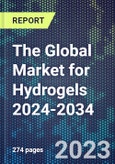The Global Market for Hydrogels 2024-2034 provides a comprehensive analysis of the global hydrogel landscape, technologies, companies, and applications across major industry verticals. It examines market drivers, trends, revenues, SWOT analyses, and hydrogel products across healthcare, water management, agriculture, construction, electronics, energy, and more.
The report profiles over 70 leading companies developing innovative hydrogel technologies and products. It covers natural and synthetic hydrogel chemistries, smart hydrogels, self-healing hydrogels, conductive hydrogels, 4D printing, and emerging chemistries.
Detailed application segments analyze hydrogels for wound care, drug delivery, medical implants, biosensors, flexible electronics, batteries, fuel cells, solar cells, self-healing concrete, lubricants, agriculture, food packaging, and water purification. Regional and global market forecasts are provided. This study serves as a strategic guide for companies and investors looking to capitalize on the major growth opportunities for hydrogels across a diverse set of high-potential markets and applications.
Report contents include:
- Overview of hydrogel properties, classifications, synthesis methods, formulations
- Analysis of natural vs synthetic hydrogels, emerging chemistries
- Smart hydrogels: thermosensitive, pH-sensitive, self-healing, shape memory
- Advanced hydrogels: luminescent, nanomaterial-based, 3D/4D printed
- Hydrogel market size, growth forecasts across industries: healthcare, water, agriculture, construction, electronics, energy, sensors, membranes
- Healthcare applications: wound care, drug delivery, implants, tissue engineering, cosmetics, biosensors
- Water purification methods: adsorption, solar evaporation, filtration, magnetics
- Agriculture uses: fertilizers, soil amendments, livestock feed, seed coatings
- Construction applications: self-healing concrete, thermal management, humidity control
- Flexible electronics uses: batteries, supercapacitors, printed circuits, transistors
- Energy applications: battery electrodes & electrolytes, fuel cell membranes, solar cells
- Sensors and membrane applications: chemical separation, bioreactors, drug delivery
- Profiles of 70 leading companies developing innovative hydrogel technologies and products. Companies profiled include AmacaThera, Amferia AB, Boston Scientific, Hydrogel Concrete Solutions, Nexgel, Polyrizon Ltd, PneumoNIX, Surge Therapeutics, and Ventrix Bio.
- SWOT analysis examining strengths, weaknesses, opportunities and threats for hydrogels in major application markets
- Growth drivers, trends, and challenges in key hydrogel application areas
This product will be delivered within 1-3 business days.
Table of Contents
1 RESEARCH METHODOLOGY2 TERMS AND DEFINITIONS
Companies Mentioned (Partial List)
A selection of companies mentioned in this report includes, but is not limited to:
- FibDex
- GelrinC
- GelSana Therapeutics
- MEDAGEL
- MEDICELLU
- mediNiK
- Nix Biosensors
- PeptiGels
Methodology

LOADING...








